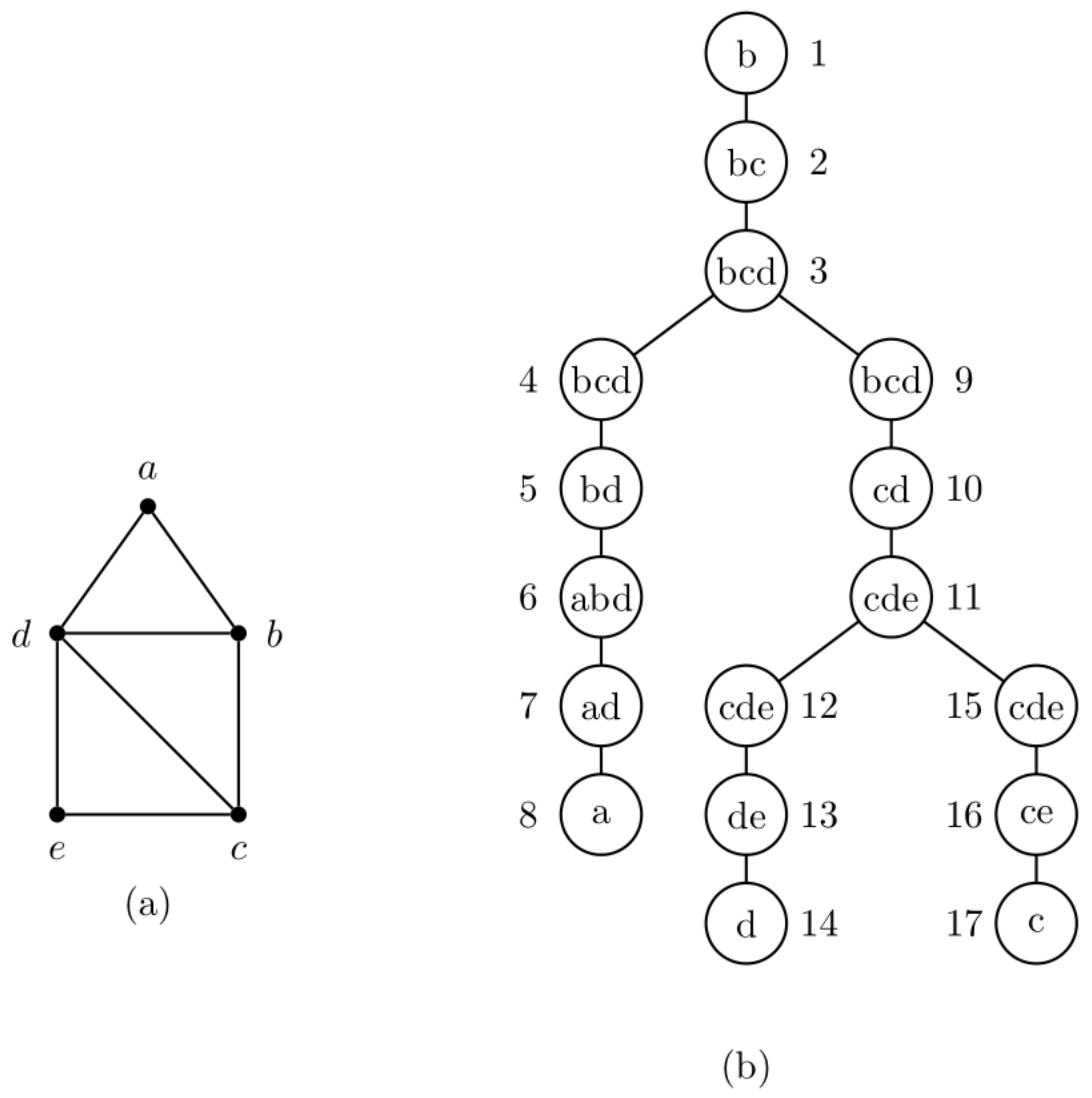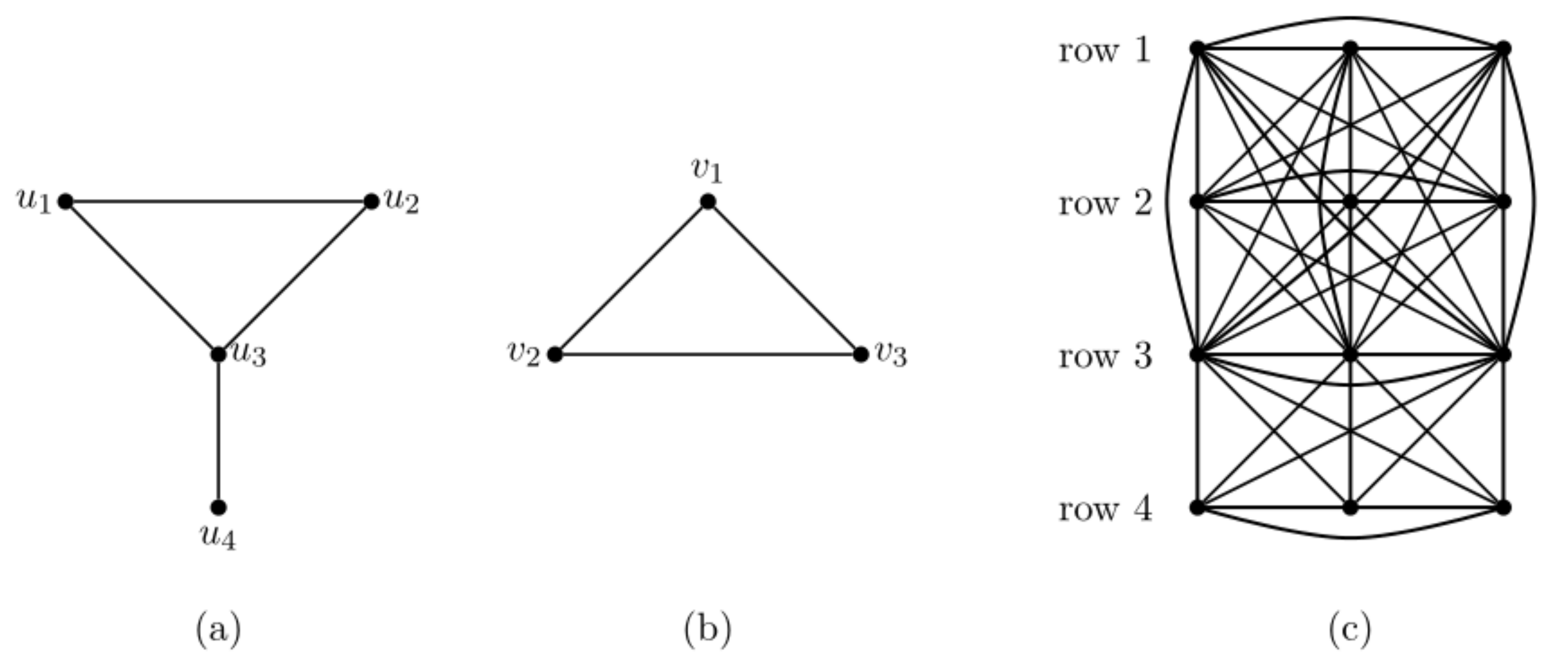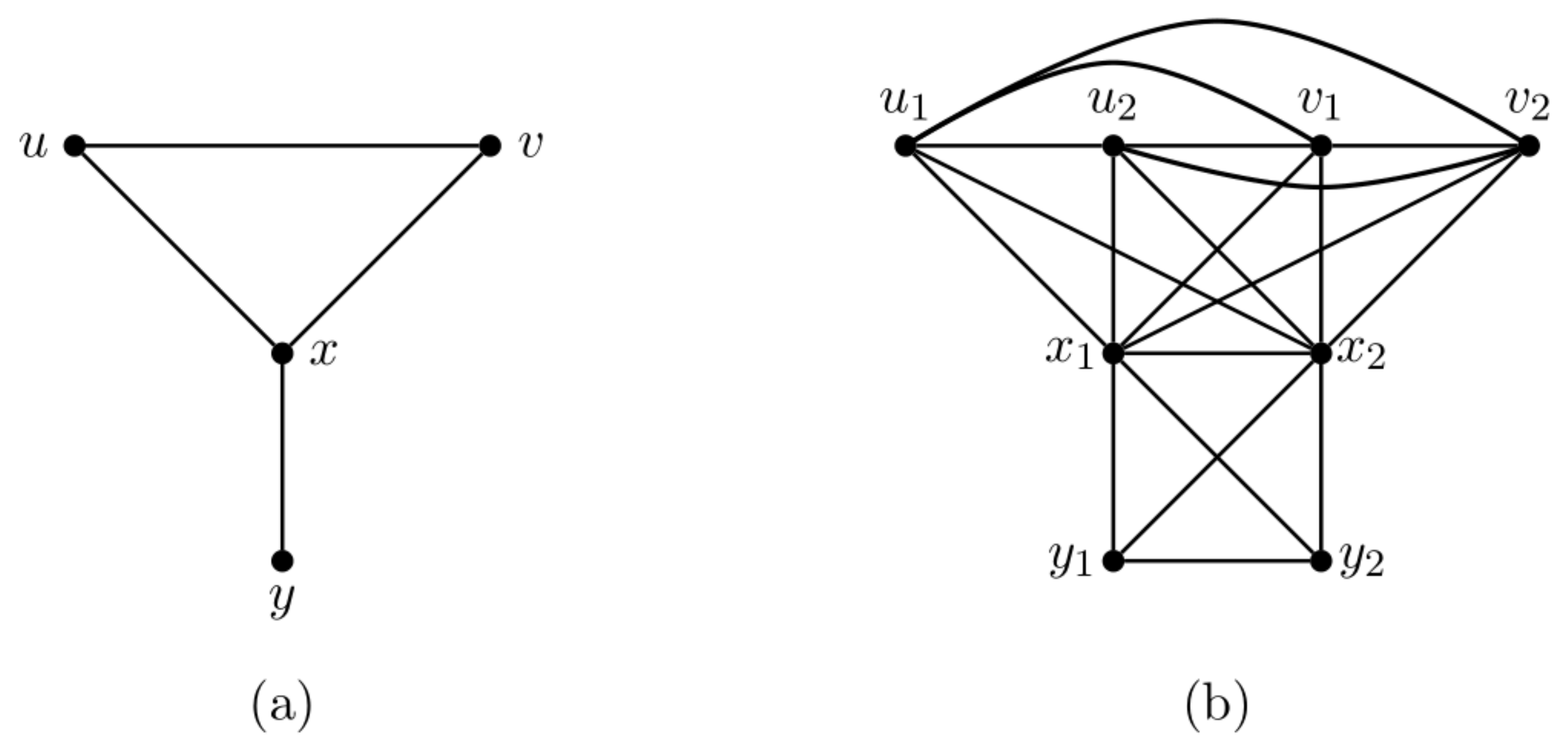Remarks on Parameterized Complexity of Variations of the Maximum-Clique Transversal Problem on Graphs
Abstract
:1. Introduction
- Section 2 reviews the definitions of the considered problems and the most well-known notions from graph theory.
- We prove in Section 3 that the clique transversal problem parameterized by the solution size is -complete for split graphs, and the following problems are para-NP-complete: the minus maximum-clique transversal problem parameterized by the solution weight for planar graphs, and the signed maximum-clique transversal problem parameterized by the solution weight for doubly chordal graph and planar graphs with clique number three.
- We show the FPT results for graphs of bounded treewidth in Section 4.
- Section 4.1 shows that the k-fold maximum-clique transversal problem can be solved in time for any graph G with bounded treewidth .
- Section 4.2 reduces the -maximum-clique transversal problem to the k-fold maximum-clique transversal problem and solves the problem in time. We develop a dynamic programming algorithm to improve the complexity of the problem to time.
- Section 4.3 deals with the signed and minus maximum-clique transversal problems. We reduce the signed and minus maximum-clique transversal problems to the k-fold maximum-clique transversal problem and solve these problems in and time, respectively. The complexity of the minus maximum-clique transversal problem for graphs of bounded treewidth can be improved to by our dynamic programming technique used for the -maximum-clique transversal problem.
- Finally, we conclude the paper and present some future works in Section 5.
2. Definitions and Notations
3. The Fixed-Parameter Intractable Results
- The nonpositive minus maximum-clique transversal problem.Instance: A graph GQuestion: Does G have a minus maximum-clique transversal function of weight at most 0?
- The nonpositive signed maximum-clique transversal problem.Instance: A graph GQuestion: Does G have a signed maximum-clique transversal function of weight at most 0?
- (1)
- If the signed (minus) maximum-clique transversal problem is NP-complete for , the nonpositive signed (minus) maximum-clique transversal problem is NP-complete for .
- (2)
- If the nonpositve signed (minus) maximum-clique transversal problem is NP-complete for graph class , the signed (minus) maximum-clique transversal problem parameterized by the solution weight is para-NP-complete for .
- (1)
- The nonpositive minus maximum-clique transversal problem is NP-complete for .
- (2)
- The nonpositive signed maximum-clique transversal problem is NP-complete for .
- (1)
- The minus maximum-clique transversal problem parameterized by the solution weight is para-NP-complete for .
- (2)
- The signed maximum-clique transversal problem parameterized by the solution weight is para-NP-complete for .
4. Fixed-Parameter Tractable Results for Graphs of Bounded Treewidth
- 1.
- Every vertex appears in at least one set .
- 2.
- For every edge , there is at least one set containing both vertices of e.
- 3.
- For each vertex , the set forms a subtree of T.
- 1.
- Every node of T has at most two child nodes.
- 2.
- If a node i has two child nodes—j and k—then . The node is called a join node.
- 3.
- If a node i has only one child node j, then either (1) and , or (2) and . In the case (1), the node is called an introduce node, whereas in the case (2), the node is called a forget node.
4.1. The k-Fold Maximum-Clique Transversal Problem
- (1)
- .
- (2)
- for every maximum clique .
4.2. The -Maximum-Clique Transversal Problem
4.2.1. Problem Solving by Reduction
- (1)
- Every vertex appears in at least one bag of B. Suppose that . The vertices , all appear in . Therefore, every vertex appears in at least one bag .
- (2)
- For any two adjacent vertices , and , or and , or and . Consider and . Either or . If , then and are in the same bags. Suppose that and . Since there is at least one bag of B containing both vertices of e for every edge , at least one bag contains the vertices and . Let . The vertices , and , are in . The bag contains and . Therefore, there is at least one bag of containing every pair of adjacent vertices of .
- (3)
- Suppose that is a vertex of and it appears in two bags . Let j be a node on the tree path from node i to node p in T. Since appears in and , we know that and . Then, by Lemma 1. The vertices , are in . Clearly, . Hence, a vertex appears in every bag for the node j on the tree path from node i to node p in T if it appears in .
4.2.2. Problem Solving by Dynamic Programming
- 1.
- denotes the -tuple .
- 2.
- denotes the -tuple .
- 3.
- denotes the -tuple such that and for .
- 4.
- denotes the -tuple .
- 5.
- denotes the -tuple such that and for .
- 6.
- A -tuple is a -partition of satisfying the following conditions.
- (a)
- .
- (b)
- for .
- 7.
- A -assignment of is a -partition of such that for every
- (1)
- .
- (2)
- for every .
4.3. The Signed and Minus Maximum-Clique Transversal Problems
- 1.
- .
- 2.
- .
- For any vertex with , D includes both of the vertices and .
- For any vertex with , D contains precisely one of the vertices and .
- For any vertex with , D comprises none of the vertices and .
- For any two vertices , if S includes both of them.
- For any two vertices , if S contains precisely one of them.
- For any two vertices , if S comprises none of them.
- (1)
- Every vertex appears in at least one bag of B. Suppose that . Since , . Therefore, every vertex of H appears in at least one bag .
- (2)
- For each edge , there is at least one bag of B containing the vertices u and v. Suppose that . Since , , , , and , are in the bag . Therefore, there is at least one bag of containing both x and y for all edges .
- (3)
- Let . Then, . Clearly, if and only if . By Lemma 1, if v appears in two bag , then it appears in every bag for the node j on the tree path from node p to node q in T. Since , and are both in and and they appear in every bag for the node j on the tree path from node p to node q in T.
5. Conclusions
- (1)
- Table 1 and Table 2 show that the respective parameterized complexities of the clique transversal, k-fold maximum-clique transversal, and -maximum-clique transversal problems remain unknown for planar graphs. Can we find fixed-parameter tractable algorithms to solve them for planar graphs if the considered problem is parameterized by the solution size or weight? Or is it possible to find improved algorithms for planar graphs of bounded treewidth?
- (2)
- In Table 2, all the considered problems parameterized by treewidth are fixed-parameter tractable. Can we prove that all the considered problems remain fixed-parameter tractable if given other parameters?
- (3)
- This paper considers only maximum cliques for simple graphs. In reality, dicliques also appear in more general directed graphs [20]. It is interesting to consider the problems for directed ones.
Funding
Institutional Review Board Statement
Informed Consent Statement
Data Availability Statement
Acknowledgments
Conflicts of Interest
References
- Chang, M.S.; Kloks, T.; Lee, C.M. Maximum clique transversals. In Proceedings of the 27th International Workshop on Graph-Theoretic Concepts in Computer Science, Boltenhagen, Germany, 14–16 June 2001; Lecture Notes in Computer Science: Berlin, Germany, 2001; pp. 32–43. [Google Scholar]
- Lee, C.-M.; Chang, M.-S. Signed and minus clique-transversal function on graphs. Inform. Process. Lett. 2009, 109, 414–417. [Google Scholar] [CrossRef]
- Lee, C.-M. Variations of maximum-clique transversal sets on graphs. Ann. Oper. Res. 2010, 181, 21–66. [Google Scholar] [CrossRef]
- Lee, C.-M. Weighted maximum-clique transversal sets of graphs. ISRN Discrete Math. 2011, 2011, 32–43. [Google Scholar] [CrossRef] [Green Version]
- Lee, C.-M. Algorithmic Aspects of Some Variations of Clique Transversal and Clique Independent Sets on Graphs. Algorithms 2021, 14, 22. [Google Scholar] [CrossRef]
- Liu, K.; Lu, M. Complete-Subgraph-Transversal-Sets problem on bounded treewidth graphs. J. Combin. Optim. 2021, 41, 923–933. [Google Scholar] [CrossRef]
- Wang, H.; Kang, L.; Shan, E. Signed clique-transversal functions in graphs. Int. J. Comput. Math. 2010, 87, 2398–2407. [Google Scholar] [CrossRef]
- Wang, H.; Shan, E. The signed maximum-clique transversal number of regular graphs. Int. J. Comput. Math. 2012, 89, 741–751. [Google Scholar] [CrossRef]
- Xu, G.; Shan, E.; Kang, L.; Chang, T.C.E. The algorithmic complexity of the minus clique-transversal problem. Appl. Math. Comput. 2007, 189, 1410–1418. [Google Scholar] [CrossRef]
- Downey, R.G.; Fellows, M.R. Parameterized Complexity; Monographs in Computer Science; Springer: New York, NY, USA, 1999. [Google Scholar]
- Alber, J.; Bodlaender, H.; Fernau, H.; Kloks, T.; Niedermeier, R. Fixed Parameter Algorithms for DOMINATING SET and Related Problems on Planar Graphs. Algorithmica 2002, 33, 461–493. [Google Scholar] [CrossRef]
- Brandstädt, A.; Le, V.B.; Spinrad, J.P. Graph Classes—A Survey; SIAM Monographs on Discrete Mathematics and Applications; SIAM: Philadelphia, PA, USA, 1999. [Google Scholar]
- Rose, D.J. Triangulated graphs and the elimination process. J. Math. Anal. Appl. 1970, 32, 597–609. [Google Scholar] [CrossRef] [Green Version]
- Kloks, T. Treewidth—Computations and Approximations; Lecture Notes in Computer Science: Berlin, Germany, 1993; p. 842. [Google Scholar]
- Arnbor, S.; Proskurowski, A. Characterization and recognition of partial 3-trees. SIAM J. Alg. Discete Meth. 1986, 7, 305–314. [Google Scholar] [CrossRef]
- Bodlaender, H.; Möhring, R.H. The pathwidth and treewidth of cographs. SIAM J. Discrete Math. 1993, 6, 181–188. [Google Scholar] [CrossRef] [Green Version]
- Alhevaz, A.; Darkooti, M.; Rahbani, H.; Shang, Y. Strong Equality of Perfect Roman and Weak Roman Domination in Trees. Mathematics 2019, 7, 997. [Google Scholar] [CrossRef] [Green Version]
- Lokshtanov, D.; Marx, D.; Saurabh, S. Known Algorithm on Graphs of Bounded Treewidth Are Probably Optimal. ACM Trans. Algorithms 2018, 14, 30. [Google Scholar] [CrossRef] [Green Version]
- Impagliazzo, R.; Paturi, R. On the complexity of k-SAT. J. Comput. Syst. Sci. 2001, 62, 275–291. [Google Scholar] [CrossRef] [Green Version]
- Shang, Y. Large dicliques in a directed inhomogeneous random graph. Int. J. Comput. Math. 2013, 90, 445–456. [Google Scholar] [CrossRef]



Publisher’s Note: MDPI stays neutral with regard to jurisdictional claims in published maps and institutional affiliations. |
© 2022 by the author. Licensee MDPI, Basel, Switzerland. This article is an open access article distributed under the terms and conditions of the Creative Commons Attribution (CC BY) license (https://creativecommons.org/licenses/by/4.0/).
Share and Cite
Lee, C.-M. Remarks on Parameterized Complexity of Variations of the Maximum-Clique Transversal Problem on Graphs. Symmetry 2022, 14, 676. https://doi.org/10.3390/sym14040676
Lee C-M. Remarks on Parameterized Complexity of Variations of the Maximum-Clique Transversal Problem on Graphs. Symmetry. 2022; 14(4):676. https://doi.org/10.3390/sym14040676
Chicago/Turabian StyleLee, Chuan-Min. 2022. "Remarks on Parameterized Complexity of Variations of the Maximum-Clique Transversal Problem on Graphs" Symmetry 14, no. 4: 676. https://doi.org/10.3390/sym14040676
APA StyleLee, C.-M. (2022). Remarks on Parameterized Complexity of Variations of the Maximum-Clique Transversal Problem on Graphs. Symmetry, 14(4), 676. https://doi.org/10.3390/sym14040676






